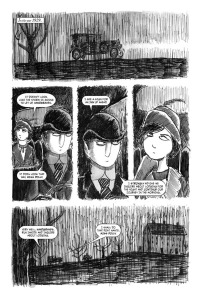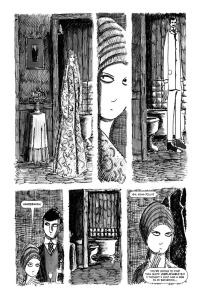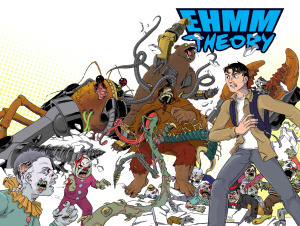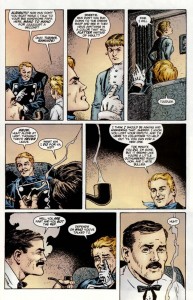(Guido Nolitta/Gallieno Ferri; EPICENTER COMICS/SERGIO BONELLI EDITORE; 2017)

What a magnificently bizarre book! The setting is kind of a Western thing (more on that later)… it’s sort of a tale of fantasy and magic… it’s basically your standard super-hero versus super-villain comic yarn (in a rather twisted Italian, anti-hero way). Call it what you will, from the beautiful Michele Rubini cover to the final panel, it is a wildly fun read! Even though I was totally unaware of the heroic exploits of the lead character, he’s been around since (depending on which website you’re checking out) either 1961 or 1965… I gather that he appeared in a regular comic STRIP in Italy until he was introduced into the comic BOOK world four years later. Whether it was ‘61 or ‘65, it makes Zagor a contemporary of Stan Lee’s Marvel universe (characters like Spider-Man, the Fantastic Four, Iron Man and Doctor Strange) and the tail-end of DC’s super-hero universe rebirth (with updated versions of the Atom, Hawkman and Green Lantern… pretty much everyone outside the publisher’s holy Trinity). For reference points within those two publisher’s Western books, the character most closely resembles the long-running (1947-1972) DC hero, TOMAHAWK, as well as later creations like Marvel’s Red Wolf and DC’s mystical hero, the original El Diablo, both of which debuted in the early 1970s. That, however, is a rather short-sighted summation of the heroic Zagor; there are also elements of the Batman, Tarzan (or maybe Ka-Zar, Marvel’s ruler of the Savage Land), Francis of Assisi (the patron Saint of ecology, among other things) and Captain America. In other words, Zagor is sort of an amalgam of every heroic figure (both real and fictional) that came before or after… I wonder just how many American comic book heroes of the late ‘60s and beyond can trace their ancestry back to the Italian comics that spawned Zagor.
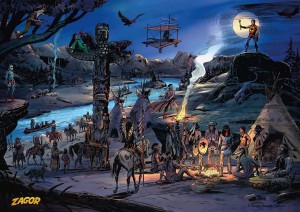
The massive – nearly 300 pages – ZAGOR VERSUS SUPERMIKE saga originally appeared in issues 122-125 of the hero’s book, published between September and December, 1975 and it features all of the hallmarks of every title published by Marvel, DC, Charlton and Gold Key from the mid-1960s through the early 1980s, including the artwork. Without getting into too many specifics, I can identify stylistic reference points to the highly underrated Herb Trimpe (who spent seven years drawing THE INCREDIBLE HULK), Sal Buscema (who followed Trimpe with a remarkable ten year run on the same book and is also known for long stints on THE DEFENDERS and THE SPECTACULAR SPIDER-MAN, among others), Buscema’s big brother, John, DC workhorse Bob Brown, the legendary John Romita, famed SUPERMAN artist Curt Swan and Dell and Gold Key stalwart Tom Gill. That, my friends, puts artist (and Zagor co-creator) Gallieno Ferri in pretty heady company. The unidentified colorist is masterful, as well, in a retro-’70s kinda way; the original Italian books were published in black and white and this particular edition utilizes the solid bright colors of American comics of the time (as in, none of the major shading or gradation effects that have become the norm in this age of – admittedly superior – computer-generated color).
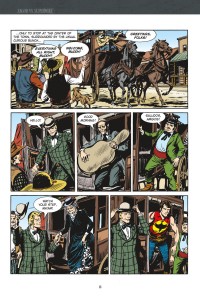
Guido Nolitta’s (the pseudonym of co-creator and publisher Sergio Bonelli) story is as rollicking and freewheeling as you would expect from any American-style Western comic (or movie) from the period immediately prior to such fare taking on much darker tones in story and character. In fact, the tale may have been a bit ahead of the curve, as the figure of Supermike isn’t really evil so much as he is conceited, boastful and arrogant regarding his abilities. Toss in Zagor’s frustrations and a willingness to cross boundaries he said he would never cross, committing several dubious acts that belie his humble, benevolent and utterly trustworthy nature and, suddenly, the heroic lead is thrust into the unenviable role of anti-hero; likewise, the villain of the piece takes on a more sympathetic role. These are things that I’m sure Nolitta and Ferri discussed and grappled with before (and probably, even after the story was published) going ahead with the concept. From what I’ve gathered from checking out reviews and comments online and from reading the three superb – though the translations may leave a bit to be desired – essays at the front of this edition (“Zagor Versus Supermachine,” “The Immortality of an Idea!” and, especially, Darko Mrgan’s “The Clash of Vanity”), this near-seismic shift in character for Zagor was not well-embraced at the time and continues to be debated to this day amongst longtime fans of the series. As a newcomer to the character, the shift was nearly imperceptible… or maybe it was a wholly American thought process that had me thinking, “Dude, it’s about time! I woulda plowed the guy right in his perfect mouth about 250 pages ago!” It does make for good drama, though, as Zagor and his companion, Chico (who acts as comedic foil and occasional whipping boy, much like Pancho, the Kid’s loyal sidekick in the uncompromisingly upbeat stories of THE CISCO KID), struggle with how to handle a man intent on destroying the reputation and good name of Zagor among his loyal friends and legion of protectorates. As our hero trails his nemesis, he is beaten and humiliated at every turn, losing the trust of the many Native American tribes he has vowed to protect, as well as losing face with the town folk in and around his “kingdom,” known as Darkwood Forest. His close alliance with the United States Army is also stretched to the breaking point.

Before delving into this particular saga, let’s take a quick look at the hero of the piece, Zagor. Born Patrick Wilding, the son of a retired Army officer, the youngster was witness to the slaughter of his parents (a plot device which also played into the development of Batman and so many other characters from the historic halls of fiction) by a rogue band of Indians; taken in by a trapper called Wandering Fitzy, young Patrick learns to wield a common hatchet as a deadly weapon. Fueled by a lust for revenge and curious to learn more about his parents, the boy soon discovers that his father’s hands were not clean of the blood of the innocent. Conflicted, the young man who would become Zagor vowed to set things right as the friend and protector of the downtrodden and misunderstood, regardless of the color of their skin. Many of his impressive athletic skills, as well as his great physical stamina, were developed through an association with an acrobatic family named the Sullivans (a nod to a certain Boy Wonder’s family, the Flying Graysons?). As the Native American tribes came to accept Wilding’s friendship and staunch support of their human rights, they gave him the Indian name “Za-Gor Te-Nay,” which translates into “the Spirit With the Hatchet.” All of this takes place, quite naturally, in the wild and wooly American west of the late 1800s, right? Well… not quite. While Zagor is considered a hero of the “Wild West,” that “west” is actually the Northeastern Woodlands of the early nineteenth century (around 1830 or so), specifically, an unsettled region of Pennsylvania. But, then, I suppose Pennsylvania is quite a bit to the west of Italy, so I’m not gonna dwell on that one too much.
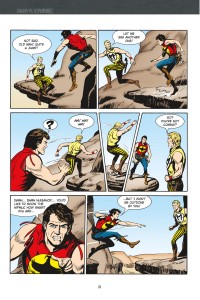
So… anyway, here’s the basic plot of ZAGOR VERSUS SUPERMIKE: Things start off, as most good Westerns generally do, with a stagecoach barreling through a barren expanse of desert (in the Appalachian Plateau region!), our hero comfortably ensconced in the carriage. Atop the coach is an irascible driver intent on making his next stop on schedule. So laser-focused on maintaining his schedule is Buddy, the driver, that he refuses to stop even when a sharp-dressed dandy in a bowler hat (something that wasn’t even around until at least fifteen years later, but… I digress) appears in the middle of the vehicles’ path; this dandy is none other than Mike Gordon, who has dubbed himself “Supermike,” a true legend in his own mind. As Zagor, Chico and the other passengers question the driver’s motivation for refusing to stop, a very surprised Buddy comes flying past the window. The athletically gifted Mister Gordon, taking umbrage with the driver, had caught up with and climbed aboard the stagecoach, heaving the hapless Buddy over the side and, reigning in the team, begins to pummel the man before Zagor can step in and stop him. The boastful New Yorker regales his fellow passengers with tales of his expertise in many different areas, proving his point by playing a rare and expensive flute perfectly and schooling an elderly woman on the finer points of crocheting. Upon reaching their destination, Supermike makes short work of a local whose prime source of income is menial labor utilizing his exceptional strength. By that evening, Zagor has had quite enough of this Mike Gordon’s superiority complex, as he bests a table of local card sharps before returning their money and buying the entire saloon drinks. When a notorious gunfighter draws down on the town’s sheriff, Zagor is drawn further into Gordon’s web of conceit as the man makes no effort to stop the outlaw; wounding the sheriff, the miscreant is taken out rather handily by Zagor. Later, on the stage out of town, Supermike’s reason for not interfering with the gunman is made obvious: Gordon was merely setting up a confrontation for later to prove his mastery of guns by beating the unbeatable “Flash” Cadigan to the draw. For the King of Darkwood Forest, this is a step too far, leading to a confrontation with the braggadocious Gordon; a confrontation that sees Zagor losing his temper and having to be restrained, leaving Supermike battered, bloody and swearing revenge. That revenge – a total dismantling of Zagor’s life and world – takes up the remainder of the action-filled story. Without giving away any more of the story’s twists and turns, I’ll just say that ZAGOR VERSUS SUPERMIKE gives the reader everything they could hope for in a nostalgic look back at a simpler time in comic book storytelling. This digest-sized presentation is Epicenter Comics’ fourth omnibus offering of some of Zagor’s more epic adventures from this period, with more to come. I, for one, can’t wait.


















